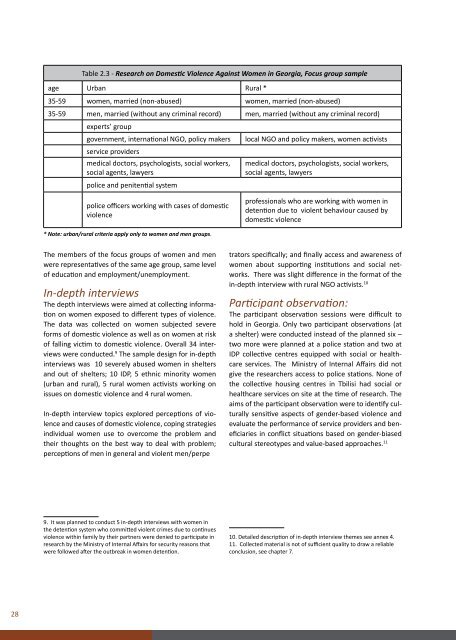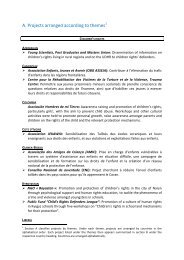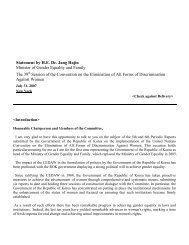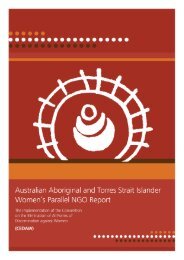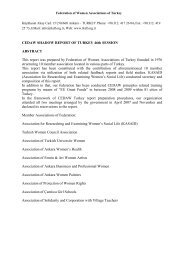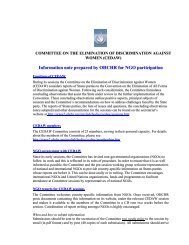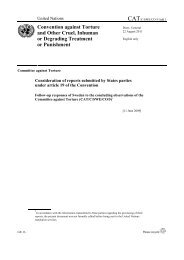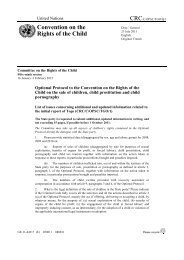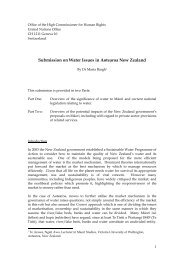a) Understand<strong>in</strong>g of the c<strong>on</strong>cept of violence by womenand men (percepti<strong>on</strong>s and attitudes, experiences andcop<strong>in</strong>g strategies);b) Identify<strong>in</strong>g the pers<strong>on</strong>al, <strong>in</strong>stituti<strong>on</strong>al and culturalpeculiarities of gender-based violence <strong>in</strong> Georgiac) Identify<strong>in</strong>g country-specific features <strong>in</strong> order to developpolicies for combat<strong>in</strong>g gender-based violence.The qualitative data was collected <strong>in</strong> focus group discussi<strong>on</strong>sand <strong>in</strong>-depth <strong>in</strong>terviews, as well as two participantobservati<strong>on</strong>s. The tra<strong>in</strong><strong>in</strong>g for the qualitative researchpart was designed specifically for more qualified graduatestudents <strong>in</strong> gender studies from Tbilisi State University.Graduate students already had sufficient experience<strong>in</strong> fieldwork <strong>on</strong> gender related issues and were atthe stage of masters’ thesis writ<strong>in</strong>g. Dur<strong>in</strong>g there studiesat masters course students were tra<strong>in</strong>ed <strong>in</strong> research ethicsas well as sensitivity matters of the issue and subjectsof domestic violence. The tra<strong>in</strong><strong>in</strong>g for the qualitative researchwas given <strong>in</strong> May 2009 and covered qualitativeresearch methodology and guidel<strong>in</strong>es for <strong>in</strong>terview<strong>in</strong>gand each topic was discussed dur<strong>in</strong>g the <strong>in</strong>teractivetra<strong>in</strong><strong>in</strong>g process. All tra<strong>in</strong><strong>in</strong>g was built <strong>on</strong> role play – <strong>on</strong>e<strong>in</strong>terviewer, <strong>on</strong>e resp<strong>on</strong>dent and a group of observers.At the end of <strong>in</strong>terview each party shared their thoughtsand identified weaknesses <strong>in</strong> questi<strong>on</strong>s or <strong>in</strong>terviewers’c<strong>on</strong>duct. There was not any specific tra<strong>in</strong><strong>in</strong>g for thefocus group moderator as the experienced academic(TSU professor) was the <strong>on</strong>ly moderator for all 10 focusgroups. The qualitative methodology was used to collectthe data <strong>in</strong> <strong>in</strong> Samtskhe-Javakheti regi<strong>on</strong> with<strong>in</strong> theframes of UNIFEM-adm<strong>in</strong>istered UN Trust Fund to End<strong>Violence</strong> <strong>Aga<strong>in</strong>st</strong> <strong>Women</strong> funded Project “Interdepartmentaland Public Measures for Elim<strong>in</strong>ati<strong>on</strong> of Family<strong>Violence</strong> <strong>in</strong> Georgia”. The follow<strong>in</strong>g organizati<strong>on</strong>s:<strong>Women</strong>’s Informati<strong>on</strong> Center, Internati<strong>on</strong>al AdvisoryCenter for Educati<strong>on</strong> of <strong>Women</strong>, Democrat <strong>Women</strong>’s Organizati<strong>on</strong>,<strong>Women</strong>’s Hope and “Dynamic Psychology forDevelopment and Democracy” took part <strong>in</strong> the project.With<strong>in</strong> the above menti<strong>on</strong>ed project 4 focus groups and9 <strong>in</strong>-depth <strong>in</strong>terviews were c<strong>on</strong>ducted. 6 Interviewers,representatives of NGO <strong>Women</strong>’s Informati<strong>on</strong> Center,who have the experience work<strong>in</strong>g with severe abusedwomen, were tra<strong>in</strong>ed with masters’ students of GenderStudies. The collected material was analyzed with UN-FPA survey data, 7Focus groups:Data collected with<strong>in</strong> the focus group aimed to collectfirst-hand <strong>in</strong>formati<strong>on</strong> about the underly<strong>in</strong>g differencesbetween men’s and women’s of understand<strong>in</strong>g of violence,practices of domestic violence, experiences ofparticipants, their percepti<strong>on</strong> and cop<strong>in</strong>g strategies towardsviolence and their evaluati<strong>on</strong> and visi<strong>on</strong> about theservices provided to the victims of domestic violence.Group compositi<strong>on</strong>:• <strong>Women</strong> – three groups. Selecti<strong>on</strong> criteria: rural (2)and urban (1), age 35-59, vocati<strong>on</strong>al or higher educati<strong>on</strong>,employed and currently unemployed (whohad been work<strong>in</strong>g but have been unemployed for atleast five years).• Men – three groups. Selecti<strong>on</strong> criteria: rural (2) andurban (1), age 35-59, vocati<strong>on</strong>al or higher educati<strong>on</strong>,employed and currently unemployed (who had beenwork<strong>in</strong>g but have been unemployed for at least fiveyears).• Experts <strong>in</strong> domestic violence – three groups. Selecti<strong>on</strong>criteria: Governmental and <strong>in</strong>ternati<strong>on</strong>al NGOrepresentatives, policy makers (1), local NGO leadersand policy makers, women activists (2).• Service providers - three groups. Selecti<strong>on</strong> criteria:professi<strong>on</strong>als – medical doctors, psychologists, socialworkers, social agents, lawyers work<strong>in</strong>g with victims<strong>in</strong> various sett<strong>in</strong>gs• Police officers and penitential system officials – twogroups. Selecti<strong>on</strong> criteria: police who work <strong>on</strong> issuesof domestic violence; penitential system pers<strong>on</strong>nelwho work with women <strong>in</strong> detenti<strong>on</strong> due toviolent behaviour which resulted from domestic violence.It should be emphasized that the questi<strong>on</strong>s for discussi<strong>on</strong>were slightly modified based <strong>on</strong> the focus groupcategory. 86. Overall 14 focus groups and 34 <strong>in</strong>-depth <strong>in</strong>terviews were analyzed.Anallysis of qualitative research see chapter 7.7. Moderator for the focus groups <strong>in</strong> Samtskhe-Javekheti was thesame academic who lead the all 10 focus groups <strong>in</strong> UNFPA survey2009.and two employees of NGO <strong>Women</strong> Infrmati<strong>on</strong> Center werecollect<strong>in</strong>g <strong>in</strong>terviews .8. Detailed descripti<strong>on</strong> for topics <strong>in</strong> focus group discussi<strong>on</strong> see annex 4.NATIONAL RESEARCH ON DOMESTIC VIOLENCE AGAINST WOMEN IN GEORGIA27
Table 2.3 - <str<strong>on</strong>g>Research</str<strong>on</strong>g> <strong>on</strong> <strong>Domestic</strong> <strong>Violence</strong> <strong>Aga<strong>in</strong>st</strong> <strong>Women</strong> <strong>in</strong> Georgia, Focus group sampleage Urban Rural *35-59 women, married (n<strong>on</strong>-abused) women, married (n<strong>on</strong>-abused)35-59 men, married (without any crim<strong>in</strong>al record) men, married (without any crim<strong>in</strong>al record)experts’ groupgovernment, <strong>in</strong>ternati<strong>on</strong>al NGO, policy makers local NGO and policy makers, women activistsservice providersmedical doctors, psychologists, social workers,social agents, lawyerspolice and penitential systemmedical doctors, psychologists, social workers,social agents, lawyerspolice officers work<strong>in</strong>g with cases of domesticviolenceprofessi<strong>on</strong>als who are work<strong>in</strong>g with women <strong>in</strong>detenti<strong>on</strong> due to violent behaviour caused bydomestic violence* Note: urban/rural criteria apply <strong>on</strong>ly to women and men groups.The members of the focus groups of women and menwere representatives of the same age group, same levelof educati<strong>on</strong> and employment/unemployment.In-depth <strong>in</strong>terviewsThe depth <strong>in</strong>terviews were aimed at collect<strong>in</strong>g <strong>in</strong>formati<strong>on</strong><strong>on</strong> women exposed to different types of violence.The data was collected <strong>on</strong> women subjected severeforms of domestic violence as well as <strong>on</strong> women at riskof fall<strong>in</strong>g victim to domestic violence. Overall 34 <strong>in</strong>terviewswere c<strong>on</strong>ducted. 9 The sample design for <strong>in</strong>-depth<strong>in</strong>terviews was 10 severely abused women <strong>in</strong> sheltersand out of shelters; 10 IDP, 5 ethnic m<strong>in</strong>ority women(urban and rural), 5 rural women activists work<strong>in</strong>g <strong>on</strong>issues <strong>on</strong> domestic violence and 4 rural women.In-depth <strong>in</strong>terview topics explored percepti<strong>on</strong>s of violenceand causes of domestic violence, cop<strong>in</strong>g strategies<strong>in</strong>dividual women use to overcome the problem andtheir thoughts <strong>on</strong> the best way to deal with problem;percepti<strong>on</strong>s of men <strong>in</strong> general and violent men/perpetrators specifically; and f<strong>in</strong>ally access and awareness ofwomen about support<strong>in</strong>g <strong>in</strong>stituti<strong>on</strong>s and social networks.There was slight difference <strong>in</strong> the format of the<strong>in</strong>-depth <strong>in</strong>terview with rural NGO activists. 10Participant observati<strong>on</strong>:The participant observati<strong>on</strong> sessi<strong>on</strong>s were difficult tohold <strong>in</strong> Georgia. Only two participant observati<strong>on</strong>s (ata shelter) were c<strong>on</strong>ducted <strong>in</strong>stead of the planned six –two more were planned at a police stati<strong>on</strong> and two atIDP collective centres equipped with social or healthcareservices. The M<strong>in</strong>istry of Internal Affairs did notgive the researchers access to police stati<strong>on</strong>s. N<strong>on</strong>e ofthe collective hous<strong>in</strong>g centres <strong>in</strong> Tbilisi had social orhealthcare services <strong>on</strong> site at the time of research. Theaims of the participant observati<strong>on</strong> were to identify culturallysensitive aspects of gender-based violence andevaluate the performance of service providers and beneficiaries<strong>in</strong> c<strong>on</strong>flict situati<strong>on</strong>s based <strong>on</strong> gender-biasedcultural stereotypes and value-based approaches. 119. It was planned to c<strong>on</strong>duct 5 <strong>in</strong>-depth <strong>in</strong>terviews with women <strong>in</strong>the detenti<strong>on</strong> system who committed violent crimes due to c<strong>on</strong>t<strong>in</strong>uesviolence with<strong>in</strong> family by their partners were denied to participate <strong>in</strong>research by the M<strong>in</strong>istry of Internal Affairs for security reas<strong>on</strong>s thatwere followed after the outbreak <strong>in</strong> women detenti<strong>on</strong>.10. Detailed descripti<strong>on</strong> of <strong>in</strong>-depth <strong>in</strong>terview themes see annex 4.11. Collected material is not of sufficient quality to draw a reliablec<strong>on</strong>clusi<strong>on</strong>, see chapter 7.28


